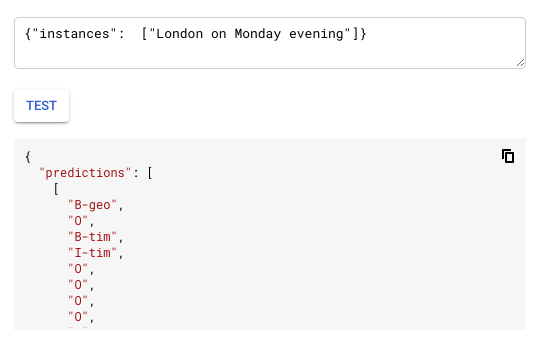mirror of https://github.com/kubeflow/examples.git
* added named entity recognition example https://github.com/kubeflow/website/issues/853 * added previous and next steps * changed all absolute links to relative links * changed headline for better understanding * moved dataset description section to top * fixed style * added missing Jupyter notebook * changed headline * added link to documentation * fixed meaning of images and components * adapted documentation to https://www.kubeflow.org/docs/about/style-guide/#address-the-audience-directly * added link to ai platform models * make it clear these are optional extensions * changed summary and goals * added kubeflow version * fixed s/an/a/ also checked the rest of the documentation * added #!/bin/sh * added environment variables for build scripts and adapted documentation * changed PROJECT TO PROJECT_ID * added link to kaggle dataset and removed not required copy script (due to direct public location in gs://). Adapted Jupyter notebook input data path * added hint to make clear no further steps are required * fixed s/Run/RUN/ * grammar fix * optimized text * added prev link to index * removed model description due to lack of information * added significance and congrats =) * added example * guided the user's attention to specific screens/metrics/graphs * explenation of pieces * updated main readme * updated parts * fixed typo * adapted dataset path * made scripts executable chmod +x * Update step-1-setup.md swaped sections and added env variables to gsutil comand * added information regarding public access * added named entity recognition example https://github.com/kubeflow/website/issues/853 * added previous and next steps * changed all absolute links to relative links * changed headline for better understanding * moved dataset description section to top * fixed style * added missing Jupyter notebook * changed headline * added link to documentation * fixed meaning of images and components * adapted documentation to https://www.kubeflow.org/docs/about/style-guide/#address-the-audience-directly * added link to ai platform models * make it clear these are optional extensions * changed summary and goals * added kubeflow version * fixed s/an/a/ also checked the rest of the documentation * added #!/bin/sh * added environment variables for build scripts and adapted documentation * changed PROJECT TO PROJECT_ID * added link to kaggle dataset and removed not required copy script (due to direct public location in gs://). Adapted Jupyter notebook input data path * added hint to make clear no further steps are required * fixed s/Run/RUN/ * grammar fix * optimized text * added prev link to index * removed model description due to lack of information * added significance and congrats =) * added example * guided the user's attention to specific screens/metrics/graphs * explenation of pieces * updated main readme * updated parts * fixed typo * adapted dataset path * made scripts executable chmod +x * Update step-1-setup.md swaped sections and added env variables to gsutil comand * added information regarding public access * fixed lint error * fixed lint issues * fixed lint issues * figured kubeflow examples are using 2 rather then 4 spaces (due to tensorflow standards) * lint fixes * reverted changes * removed unused import * removed object inherit * fixed lint issues * added kwargs to ignored-argument-name (due to best practice in Google custom prediction routine) * fix lint issues * set pylintrc back to default and removed unused argument |
||
|---|---|---|
| .. | ||
| components | ||
| documentation | ||
| notebooks | ||
| routine | ||
| .gitignore | ||
| README.md | ||
README.md
Named Entity Recognition with Kubeflow and Keras
In this walkthrough, you will learn how to use Kubeflow to build reusable components to train your model on an kubernetes cluster and deploy it to AI platform.
Goals
- Demonstrate how to build reusable pipeline components
- Demonstrate how to use Keras only models
- Demonstrate how to train a Named Entity Recognition model on a Kubernetes cluster
- Demonstrate how to deploy a Keras model to AI Platform
- Demonstrate how to use a custom prediction routine
- Demonstrate how to use Kubeflow metrics
- Demonstrate how to use Kubeflow visualizations
What is Named Entity Recognition
Named Entity Recognition is a word classification problem, which extract data called entities from text.
